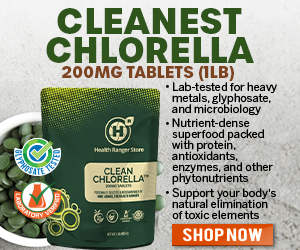
Medicinal properties of sage revealed
 Wednesday, November 18, 2009 Wednesday, November 18, 2009by Mike Adams, the Health Ranger Editor of NaturalNews.com (See all articles...) Tags: sage, herb, health news |
- The 20 deadliest sugar-loaded foods and how to replace them before they kill you
- Scientists discover Earth's core is leaking gold and precious metals through volcanic activity
- An inexpensive and forgotten superfood: BEANS are key to reversing chronic disease
- Globalists call for “celebration” of plunging human fertility as war against humanity accelerates
- $93B Energy loan scandal during Biden’s final days EXPOSED
- Hidden food chemicals in many “health” foods linked to gut damage, cancer, and metabolic disorders
- WHO Pandemic Treaty sparks sovereignty concerns amid secretive voting and U.S. withdrawal
- DOGE exposes Social Security chaos: 12.3 million flagged as 120+ years old, 2.1 million non-citizens issued numbers in 2024
- Putin's helicopter caught in “unprecedented” Ukrainian drone assault during secret war zone trip
- Biden regime weaponized terror watch lists to silence COVID mandate dissent, documents expose
- AI model Claude Opus 4 threatened engineers with blackmail in simulated shutdown scenario
- Famous NFL quarterback Aaron Rodgers featured on Joe Rogan Experience throws COVID mRNA CLOT SHOTS under the bus
- Senate report: Biden FDA and CDC failed to warn Americans about COVID-19 vaccine’s cardiovascular risks
- Psychic prophecy rattles Japan's tourism as July approaches
- Elon Musk exits government role, refocuses on Tesla and X after data center failure
- HEALTH SECRETS: How to Instantly Block MSG Toxicity Using Natural Substances (and the secret of Methylene Blue)
- Big Chemical Ag wants IMMUNITY from LAWSUITS for their mass genocide of farmers and consumers who ingest and consume their deadly pesticides
- Big Pharma's Dirty Secret: How Prescription Drugs Are Starving Your Body of Essential Nutrients
- Globalists call for “celebration” of plunging human fertility as war against humanity accelerates
- HEALTH SECRETS: How to Instantly Block MSG Toxicity Using Natural Substances (and the secret of Methylene Blue)
- Lost 5,000-year-old civilization uncovered beneath Arabian sands
- WAR ON COGNITION: The Coordinated Assault on Your Brain and How to Defend Yourself Against Every Attack
- Government-backed group acknowledges targeting Trump, silencing conservative outlets: Critics warn of free speech erosion
- MSG EXPOSED: Hidden Neurotoxins Found in Groceries, Snacks and Popular Fast Food Menus
- Big Pharma's Dirty Secret: How Prescription Drugs Are Starving Your Body of Essential Nutrients
- America's AI apathy: How resistance to artificial intelligence will leave the U.S. in the dust
- Merck's mumps fraud: A 50-year cover-up exposed as vaccine efficacy claims crumble
- METHOD OF OPERATION SINISTER: Get everyone vaccinated for Covid BEFORE they figure out how deadly the mRNA jabs really are - that was the plot
- WHO Pandemic Treaty sparks sovereignty concerns amid secretive voting and U.S. withdrawal
- Microsoft exposed for SILENCING EMAILS that discuss genocide in Gaza, while fueling Israel's war machine with AI and cloud tech
- RED ALERT: Nuclear War Between India and Pakistan Could Trigger Global Catastrophe… full RISK ANALYSIS
- FDA forces Pfizer, Moderna to admit COVID vaccines cause lasting heart damage in young males
- Independent journalists launch decentralized news portal to resist Big Tech censorship
- The 20 deadliest sugar-loaded foods and how to replace them before they kill you
- 7 Powerful allergy remedies backed by science
- 6-month-old dies just hours after taking SIX routine vaccines at a “wellness visit”: Parents demand justice as SIDS COVERUP unravels
- URGENT REPORT: The China Import Embargo - What to Stockpile Now Before America Runs Out
- Big Pharma's Dirty Secret: How Prescription Drugs Are Starving Your Body of Essential Nutrients
- RED ALERT: Nuclear War Between India and Pakistan Could Trigger Global Catastrophe… full RISK ANALYSIS
- Singapore's draconian vaccine mandate: Citizens face jail time for refusing FORCED medical procedures that do HARM
- WAR ON COGNITION: The Coordinated Assault on Your Brain and How to Defend Yourself Against Every Attack
- U.S. Government's Bio-War Against America: 15 Historical Medical Horrors Inflicted on the American People by the Government Itself
- Head of L.A. Port warns of incoming plunge in U.S. supply chain, empty shelves and inventory depletion in 5-7 weeks
- Big Pharma launches “Vaccine Integrity Project” to combat Secretary Kennedy and keep 94 shots going into kids with mandates and liability protections
- EU's digital censorship SURTAX and vaccine "misinformation" CRACKDOWN targets vaccine truth seekers in Orwellian push for conformity
- Trump Unleashes Economic Doomsday on America with "Secondary Sanctions" that BLOCK all Exports from China, with NO exceptions!
- JESUS NEVER SPOKE ENGLISH: Historical facts on why the Bible you’re probably reading has been altered, redacted or hidden from much of its original meaning
- The Miraculous Healing Power of DMSO: Nature's Forgotten Cure for Cancer, Pain, and Regeneration
- Why All Government Officials and Big Tech CEOs Who Engage in Systematic Viewpoint Censorship Must Be ARRESTED, Prosecuted, and Sentenced to Life in Prison
- The Miraculous Healing Power of Green Tea: Unlocking the Potent Antioxidants That Big Pharma Doesn't Want You to Know About
- Rubio exposes Biden's surveillance of American dissent: Outrageous free speech violations
- The Ultimate Survival Guide to Baking Soda: A Miraculous, Multi-Purpose Remedy for Health, Home, and Emergency Preparedness
- MSG EXPOSED: Hidden Neurotoxins Found in Groceries, Snacks and Popular Fast Food Menus
- Why the Trump administration will FAIL, and America’s economy, military and industrial base will COLLAPSE if Trump’s weaponized tariffs aren’t halted
- Red Cross issues warning to stop blood plasma donations from vaccinated people
- Scientists confirm: GENIUS brain function can be spontaneously unleashed in humans without any apparent cause
- EPA advisor admits the agency is funneling billions to climate groups ahead of Trump’s return to White House
- HYSSOP: What research reveals about the health benefits of this ancient holy herb
- Two containers with completed ballots fall out of truck in Florida
- Newly released JFK files reveal Pentagon's role in creating Lyme disease and covid in the same lab
- Mike Adams releases country western hit single: Goin’ Back in Time is Comin’ Home
- Global leaders unite to clamp down on “misinformation” with UN-backed Cascais Declaration
- BREAKING: 2025 NDAA authorizes mandatory military draft of WOMEN across America… as Pentagon pursues global NUCLEAR war with both Russia and China at the same time
- I Want My Bailout Money – new song released by Mike Adams
- Michael Yon warns of a ZIONIST TAKEOVER in Trump’s second administration
- BOMBSHELL: DNA testing kits are a SCAM to develop ethnic-specific bioweapons
- Ozempic and Wegovy weight loss drugs are injectable LIZARD VENOM PEPTIDES that may unleash a devastating wave of organ failure… side effects align with symptoms of SNAKE BITES
- The Health Ranger releases “Vaccine Zombie” song and music video, using AI-animated zombies for the music video
- These 13 countries just signed an agreement to engineer a global FAMINE by destroying food supply
- Israeli soldiers accused of even more torture and abuse in the West Bank
- RFK Jr. clears key hurdle: Sen. Susan Collins backs controversial HHS nominee, signaling a new era for health policy
- Sermon 30: How Jesus reveals Caesar’s FAKE CURRENCY and FALSE AUTHORITY
You may not have known all these amazing health applications for such a simple herb. Check out the quotes below and learn what health experts like Dr. James Duke are saying about sage...
Medicinal benefits of sage
Sage was given the distinguished title of "Herb of the Year" in 2001 by the International Herb Association. The health benefits of sage are similar to those attributed to other members of the mint family. Sage is perhaps most similar to rosemary. The primary medicinal components in sage are volatile oils, flavonoids, and rosmarinic acid. Some of the distinct effects of sage that have been reported include anhidrotic (prevents perspiration); blood sugar-lowering effects in diabetics; antimicrobial; and drying up the flow of milk during lactation.- The Encyclopedia of Healing Foods by Michael Murray, N.D. and Joseph Pizzorno, N.D.
After taking the sage extract, the subjects felt more alert, calm, and contented, and the benefits lasted for several hours afterward. Dosage: For supplements, follow the label directions regarding dosage. For cooking, mince sage or use whole leaves to season chicken or turkey.
- The Food-Mood Solution: All-Natural Ways to Banish Anxiety, Depression, Anger, Stress, Overeating, and Alcohol and Drug Problems--and Feel Good Again by Jack Challem
Burdock, dandelion, hawthorn, licorice, pau d'arco, red clover, rhubarb, sage, shiitake mushroom, and Siberian and other ginsengs detoxify and cleanse the blood. These herbs can be used independently or in any combination. Cautions: Do not use licorice on a daily basis for more than seven days in a row, and avoid it completely if you have high blood pressure. Do not use sage if you have any kind of seizure disorder. Do not use Siberian ginseng if you have hypoglycemia or a heart disorder. Do not use any type of ginseng if you have high blood pressure.
- Prescription for Nutritional Healing, 4th Edition: A Practical A-to-Z Reference to Drug-Free Remedies Using Vitamins, Minerals, Herbs & Food Supplements by Phyllis A. Balch, CNC
Oil of sage contains a compound called thujone, an effective agent against both salmonella and Candida. Sage also contains the phenolic acid rosmarinic acid, which is both an antioxidant and an anti-inflammatory. For this reason, sage has been found to be beneficial for fighting such inflammatory conditions as gingivitis and rheumatoid arthritis. In animal research, sage was found to be antihypertensive (it lowers blood pressure). And in one study - yet to be confirmed in humans - it had an antidiabetic effect.
- The 150 Healthiest Foods on Earth: The Surprising, Unbiased Truth About What You Should Eat and Why by Jonny Bowden, Ph.D., C.N.S.
Drink an herbal sore-throat tea containing some or (preferably) all of the following: slippery elm bark, hyssop, licorice root, and sage. Hyssop and sage detoxify the blood; licorice and slippery elm soothe irritated mucous membranes and ease a sore throat. Take a cup of the tea three times daily for a couple of days or until you feel better. You can also cool the tea and use it as a gargle. Note: Do not use licorice on a daily basis for more than five days at a time, as it can elevate blood pressure. Do not use it at all if you have high blood pressure.
- Smart Medicine for Healthier Living : Practical A-Z Reference to Natural and Conventional Treatments for Adults by Janet Zand, LAc, OMD, Allan N. Spreed, MD, CNC, James B. LaValle, RPh, ND
Those with epilepsy, high blood pressure, or kidney disease may be adversely affected by the thujone content and should avoid large doses of sage. Sage is native to southeastern Europe but cultivated and naturalized elsewhere. A perennial, it often grows to a foot or more in height and has a squarish stem. The leaves grow in pairs and are grayish green in color, slightly hairy, and strongly veined. The purplish flowers grow in whorls. In the garden, sage does best in full sun and well-drained soil, with low to moderate amounts of water.
- The Desktop Guide to Herbal Medicine: The Ultimate Multidisciplinary Reference to the Amazing Realm of Healing Plants, in a Quick-study, One-stop Guide by Brigitte Mars, A.H.G.
Laura still hasn't told her doctor about the sage tea she drinks to help bring her blood sugar back to normal. But she didn't mind telling us. 'You know how doctors are - they don't want you taking anything that they haven't given you," says the 67-year-old retired medical attendant. After suffering from Type II diabetes for seven years, the Detroit resident read about the benefits of sage tea and decided to give it a try. The hard part was finding some: Sage tea sells out as quickly as it arrives at her local health-food store.
- Home Remedies: What Works: Thousands of Americans Reveal Their Favorite Home-Tested Cures for Everyday Health Problems by Gale Maleskey, Brian Kaufman
Calendula, cayenne, fennel seed, ginger, marshmallow root, sage, and slippery elm nourish the skin and promote healing. Caution: Do not use sage if you suffer from any kind of seizure disorder. Milk thistle aids the liver in cleansing blood. Nettle and rosemary improve skin tone, nourish the skin, and promote healing. Dosages may vary, depending on duration and severity of symptoms. Consult a qualified herbal practitioner.
- The Doctor's Complete Guide to Vitamins and Minerals by Dr. Mary Dan Eades
Recently published studies by a team of scientists from the Department of Microbiology and Chemotherapy at the Nippon Roche Research Center in Kamakura, Japan, indicates that powdered sage or sage tea helps to prevent blood clots from forming and is quite useful in the prevention and treatment of myocardial infarction and general coronary pains.
- Heinerman's Encyclopedia of Healing Herbs and Spices by John Heinerman
Rosemary enhances detoxification and also reduces inflammation. Sage can increase the flow of bile and liver detoxification. Garlic has abundant healing properties - it thins the blood, reduces blood pressure, lowers cholesterol, improves immunity, fights microbes, and may protect against cancer. Oregano has twelve antibiotic, antifungal, antiviral, and antiparasitic compounds. Cinnamon has antifungal properties. Burdock increases urine and sweat production.
- Ultraprevention : The 6-Week Plan That Will Make You Healthy for Life by Mark Hyman, M.D.
For heart palpitations, irritability, and insomnia with blood deficiency, combine 9 grams each of red sage root, zizyphus seeds, and Polygonum multiflorum stems. For coronary heart disease and angina, combine 9 grams each of hawthorn berries, motherwort, and red sage root.
- The Way of Chinese Herbs by Michael Tierra, L.Ac, O.M.D.
Forty patients were treated with neon laser acupuncture, retention enemas, and injection into the endometrial nodes with common sage root, which is a blood-vitalizing or blood-moving herb. In the 40 patients treated, the size of lumps diminished and symptoms disappeared in 17. Thirteen women conceived. Among these, six had suffered from fallopian tube blockage and seven from ovulatory dysfunction. There was a total amelioration rate of 97.5 percent.
- Get Healthy Now with Gary Null: A Complete Guide to Prevention, Treatment and Healthy living by Gary Null
Pau d'arco, ragwort, and wood sage can be combined and used to treat tumors and external cancers. Poke root is good for an inflamed or sore breast. Sage, like poke root, can help relieve breast inflammation and soreness.
- Prescription for Nutritional Healing, 4th Edition: A Practical A-to-Z Reference to Drug-Free Remedies Using Vitamins, Minerals, Herbs & Food Supplements by Phyllis A. Balch, CNC
Bayberry bark, burdock root, milk thistle, nettle, pau d'arco, sage, and yellow dock purify the blood, fight infection, and aid in recuperation after the trauma of illness. Caution: Do not use sage if you suffer from any kind of seizure disorder. Birch leaves and lobelia both help to reduce pain. Caution: Do not take lobelia internally on an ongoing basis. Catnip tea is a nerve tonic. It can also be used as an enema to reduce fever.
- Prescription for Nutritional Healing, 4th Edition: A Practical A-to-Z Reference to Drug-Free Remedies Using Vitamins, Minerals, Herbs & Food Supplements by Phyllis A. Balch, CNC
Anise, black cohosh, fennel, licorice, raspberry, sage, unicorn root, and wild yam root are natural estrogen promoters, as are soybean products. Caution: Do not use licorice on a daily basis for more than seven days in a row, and avoid it completely if you have high blood pressure. Do not use sage if you suffer from any type of seizure disorder.
- Prescription for Nutritional Healing, 4th Edition: A Practical A-to-Z Reference to Drug-Free Remedies Using Vitamins, Minerals, Herbs & Food Supplements by Phyllis A. Balch, CNC
Cook using garlic, onion, thyme, oregano and sage. These seasonings contain very small amounts of phytoestrogens (plant-based estrogens, such as lignans and isoflavones, that occur naturally in certain foods) and can help restore hormone balance. Cut down on caffeine. Caffeine stimulates the adrenal glands, leading to a spike in blood sugar levels followed by a plunge in blood sugar to levels even lower than before. This stresses the body and aggravates menopausal woes. If you don't want to give up coffee completely, have one cup a day with food.
- Bottom Line's Health Breakthroughs 2007 by Bottom Line Health
Although they are not quite as effective, cinnamon, eucalyptus, garlic, lemon, oregano, sage, sandalwood, tea tree and thyme can be used for the same purpose. In clinical studies, aloe vera has been shown to increase blood flow to the injured area, thus accelerating the healing process. Antiseptic and healing herbs like these can be used in salves, sprays, diluted essential oils or poultices. The type of injury and its location dictate the most appropriate application. Salves, for example, adhere to the skin and form a protective layer to protect minor scrapes and cuts.
- Herbs for Health and Healing by Kathi Keville
In addition to waving aside the dessert cart, he suggests adding vitamin-and mineral-rich vegetables and grains, more fiber, aromatic spices like thyme and sage (which fight yeast overgrowth in the intestines) and copious amounts of garlic and yogurt, along with a good multivitamin/mineral supplement. "This sort of diet is the foundation of treatment for chronic yeast infections," he explains.
- Home Remedies: What Works: Thousands of Americans Reveal Their Favorite Home-Tested Cures for Everyday Health Problems by Gale Maleskey, Brian Kaufman
I'm hedging my bets now by drinking tea made from balm, sage, hyssop, or rosemary. To make the tea, I put a teaspoon or two of herb into a cup of freshly boiled water and let it steep for maybe 5 to 10 minutes. I strain out the herbs, add a squirt of lime juice, then drink up. I'm convinced that the tea is helping to preserve my memory and protect me from Alzheimer's. Another herb that may reduce your risk of Alzheimer's is ginkgo. It works by boosting bloodflow throughout your body, including within your brain.
- The Green Pharmacy Anti-Aging Prescriptions: Herbs, Foods, and Natural Formulas to Keep You Young by James A. Duke, Ph.D.
Sage at FETCH.news
Get independent news alerts on natural cures, food lab tests, cannabis medicine, science, robotics, drones, privacy and more.
 About the author:Mike Adams (aka the "Health Ranger") is a best selling author (#1 best selling science book on Amazon.com) and a globally recognized scientific researcher in clean foods. He serves as the founding editor of NaturalNews.com and the lab science director of an internationally accredited (ISO 17025) analytical laboratory known as CWC Labs. There, he was awarded a Certificate of Excellence for achieving extremely high accuracy in the analysis of toxic elements in unknown water samples using ICP-MS instrumentation. Adams is also highly proficient in running liquid chromatography, ion chromatography and mass spectrometry time-of-flight analytical instrumentation.
About the author:Mike Adams (aka the "Health Ranger") is a best selling author (#1 best selling science book on Amazon.com) and a globally recognized scientific researcher in clean foods. He serves as the founding editor of NaturalNews.com and the lab science director of an internationally accredited (ISO 17025) analytical laboratory known as CWC Labs. There, he was awarded a Certificate of Excellence for achieving extremely high accuracy in the analysis of toxic elements in unknown water samples using ICP-MS instrumentation. Adams is also highly proficient in running liquid chromatography, ion chromatography and mass spectrometry time-of-flight analytical instrumentation.
Adams is a person of color whose ancestors include Africans and Native American Indians. He's also of Native American heritage, which he credits as inspiring his "Health Ranger" passion for protecting life and nature against the destruction caused by chemicals, heavy metals and other forms of pollution.
Adams is the founder and publisher of the open source science journal Natural Science Journal, the author of numerous peer-reviewed science papers published by the journal, and the author of the world's first book that published ICP-MS heavy metals analysis results for foods, dietary supplements, pet food, spices and fast food. The book is entitled Food Forensics and is published by BenBella Books.
In his laboratory research, Adams has made numerous food safety breakthroughs such as revealing rice protein products imported from Asia to be contaminated with toxic heavy metals like lead, cadmium and tungsten. Adams was the first food science researcher to document high levels of tungsten in superfoods. He also discovered over 11 ppm lead in imported mangosteen powder, and led an industry-wide voluntary agreement to limit heavy metals in rice protein products.
In addition to his lab work, Adams is also the (non-paid) executive director of the non-profit Consumer Wellness Center (CWC), an organization that redirects 100% of its donations receipts to grant programs that teach children and women how to grow their own food or vastly improve their nutrition. Through the non-profit CWC, Adams also launched Nutrition Rescue, a program that donates essential vitamins to people in need. Click here to see some of the CWC success stories.
With a background in science and software technology, Adams is the original founder of the email newsletter technology company known as Arial Software. Using his technical experience combined with his love for natural health, Adams developed and deployed the content management system currently driving NaturalNews.com. He also engineered the high-level statistical algorithms that power SCIENCE.naturalnews.com, a massive research resource featuring over 10 million scientific studies.
Adams is well known for his incredibly popular consumer activism video blowing the lid on fake blueberries used throughout the food supply. He has also exposed "strange fibers" found in Chicken McNuggets, fake academic credentials of so-called health "gurus," dangerous "detox" products imported as battery acid and sold for oral consumption, fake acai berry scams, the California raw milk raids, the vaccine research fraud revealed by industry whistleblowers and many other topics.
Adams has also helped defend the rights of home gardeners and protect the medical freedom rights of parents. Adams is widely recognized to have made a remarkable global impact on issues like GMOs, vaccines, nutrition therapies, human consciousness.
In addition to his activism, Adams is an accomplished musician who has released over a dozen popular songs covering a variety of activism topics.
Click here to read a more detailed bio on Mike Adams, the Health Ranger, at HealthRanger.com.
Take Action: Support Natural News by linking to this article from your website
Permalink to this article:
Embed article link: (copy HTML code below):
Reprinting this article:
Non-commercial use OK, cite NaturalNews.com with clickable link.
Follow Natural News on Facebook, Twitter, Google Plus, and Pinterest
Science News & Studies
Medicine News and Information
Food News & Studies
Health News & Studies
Herbs News & Information
Pollution News & Studies
Cancer News & Studies
Climate News & Studies
Survival News & Information
Gear News & Information
News covering technology, stocks, hackers, and more



"Big Tech and mainstream media are constantly trying to silence the independent voices that dare to bring you the truth about toxic food ingredients, dangerous medications and the failed, fraudulent science of the profit-driven medical establishment.
Email is one of the best ways to make sure you stay informed, without the censorship of the tech giants (Google, Apple, Facebook, Twitter, YouTube, etc.). Stay informed and you'll even likely learn information that may help save your own life."
–The Health Ranger, Mike Adams













































